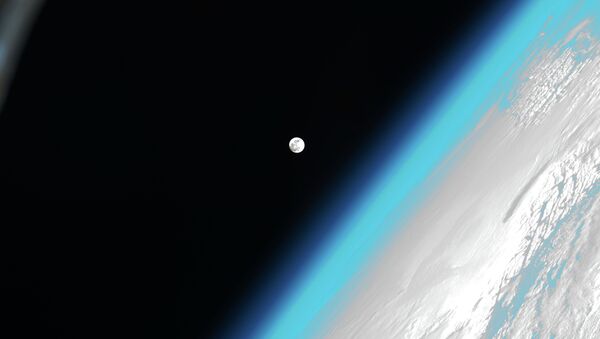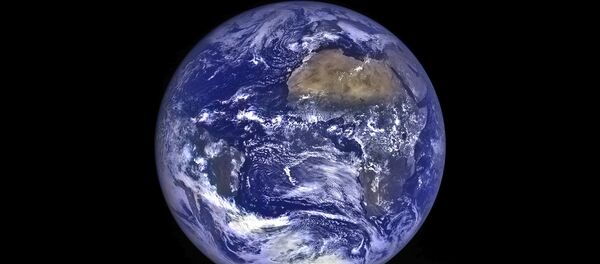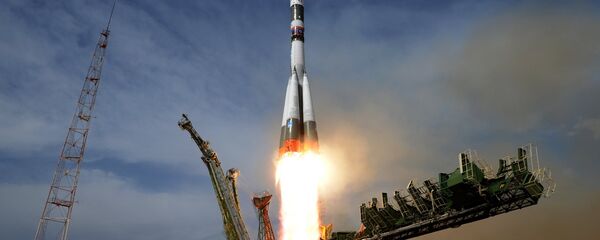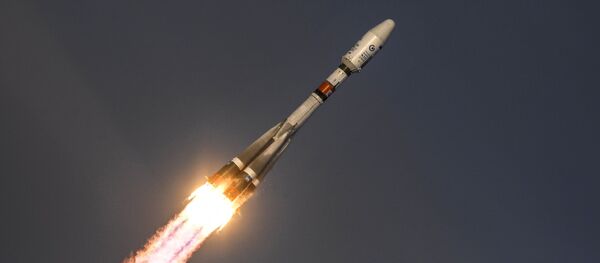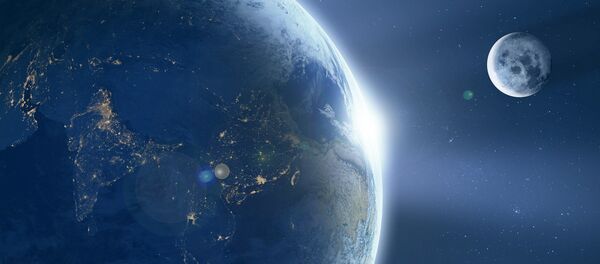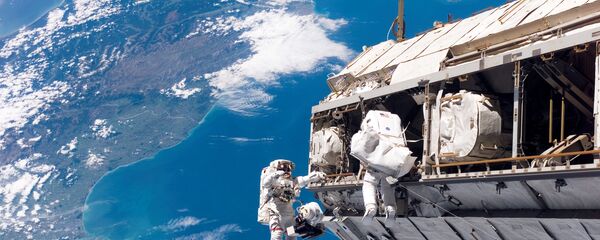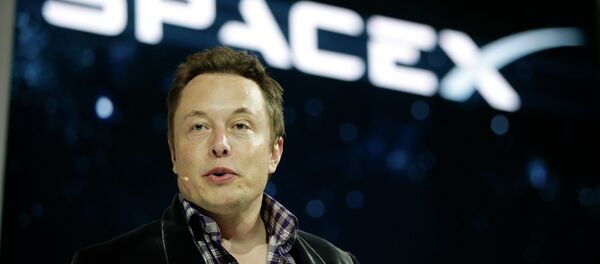For Russia’s space agency Roscosmos, the first six months of the year were relatively quiet, but things started picking up the pace in the second half of the year: mystery, treason suspicions, a lift-off accident, and financial violations.
On the night of August 30, the US Mission Control Center detected an insignificant air leak on the ISS. The pressure drop was at about 0.8 mmHg per hour, as opposed to the maximum of 0.5 mmHg allowed by the specifications, so the ground crews decided not to wake astronauts up immediately. That was the beginning of the biggest space mystery of the year.
READ MORE: Roscosmos Selects Super-Heavy Rocket Concept Designed for Moon Flights — Source
After the space crew woke up, they began to search for the leak. By that time, the pressure drop increased to 4 mmHg per hour. The crew detected the leak in the Soyuz MS-09 ship docked to the station. The leak was fixed first with tape, then with a more long-lasting solution of sealant and gauze.
Some media reports suggested one of the crew members could have drilled the hole, but US astronaut Drew Feustel, the leader of the mission, hit back against the allegations. Head of Roscosmos Dmitry Rogozin stressed that the Russian agency had never blamed the incident on the US crew, adding that some media chose to report the story in such a way.
The internal commission at Energia company, which manufactures Soyuz spacecraft, was unable to find any explanation through its investigation of the production process on Earth, so Roscosmos set up a special panel in mid-September. Cosmonauts at the ISS, Sergey Prokopyev and Oleg Kononenko, had to step out on December 11 to hunt for evidence. The track to Soyuz took three hours, rather than two as expected.
"This is heartbreaking," Kononenko said, as he pulled out a knife and stuck it into a hull.
Special scissors for metal had to be used next. Scraps of silver and gold foil along with insulation were drifting off. Cosmonauts had to cut through a meteorite-protection layer to get to the hole. Meanwhile, ground control was urging them along, as their breathing system was running close to the limit.
Prokopyev, who returned to Earth in December, brought back samples that may help solve the mystery. Authorities on the ground in Russia are expected to speak to both Prokopyev and Oleg Artemyev, another Russian cosmonaut, who was at the ISS when the leak occurred, to try to understand what happened.
Flight, Interrupted
On October 11, 2018, at 08:40 GMT, Russia’s Soyuz-FG launch vehicle with the Soyuz MS-10 spacecraft lifted off from the Baikonur space center in Kazakhstan. The Soyuz-FG rocket was carrying Russian cosmonaut Alexei Ovchinin and NASA astronaut Nick Hague. At the second minute of the flight, one of the four units of the first stage of Soyuz-FG failed to separate.
READ MORE: US Astronaut Hague 'Amazed' by Russian Rescue Team's Work After Soyuz Failure
As the Roscosmos emergency commission found out later, the sensor monitoring the separation of one of the boosters from the rocket was deformed during assembly at the cosmodrome. As a result, one of the booster’s stages slid down and hit the rocket’s core, prompting electronics to launch an automatic escape system, ejecting Ovchinin and Hague in a capsule.
In order to prevent such accidents in the future, the commission decided to recheck all the Soyuz rockets that had been assembled before, recertify the assemblers at Baikonur Cosmodrome and monitor the assembly through video recording.
The successful launch of Soyuz-FG on December 3 confirmed the effectiveness of the new measures. Incidentally, Soyuz-FG has three more launches to make until its retirement. Afterwards, the task will be carried out by the new Soyuz-2 carrier rocket.
Roscosmos announced that Ovchinin and Hague would make another attempt to reach the ISS on March 1, 2019.
The accident became the first failure of a manned space launch in the last 35 years of Russia’s space exploration.
The reshuffle, Spies, Money Lost
Apart from the outer-space tribulations, Roscosmos went through some internal reshuffle this year. The structure of the corporation was changed. The number of CEO deputies increased from seven to 10, and the number of executive directors was reduced from 12 to eight.
READ MORE: Russia Mulls Creating Long-Term Moon Base — Roscosmos
Rogozin, appointed the head of Roscosmos in May, told Sputnik in November that reforms in the Russian space industry were expected to continue. Three new holdings specializing in engine manufacturing, electronics, and rockets will be set up to work on a super-heavy-lift launch vehicle.
Meanwhile, Russian media reported in July that the Federal Security Service (FSB) had carried out searches at the TsNIIMash, a rocket and spacecraft scientific centre for Roscosmos, as part of the investigation into a high treason case. Several employees were reportedly questioned on suspicion of working for foreign intelligence and leaking top-secret designs for hypersonic devices. It emerged later that 74-year-old Viktor Kudryavtsev was suspected of sharing hypersonic development information with von Karman Institute for Fluid Dynamics in Brussels. According to Roscosmos, the investigation concerned the events that took place in 2013.
In late November, Roscosmos said it would hold special training sessions for its employees with the company’s cryptography experts to ensure that state secrets are secure.
Vladimir Ustimenko, the company’s spokesman, told Sputnik that the violations uncovered by prosecutors were from 2004-2014, therefore, they concerned the Federal Space Agency, the predecessor of Roscosmos.
Russian Prime Minister Dmitry Medvedev weighed in on the matter blasting the federal space program implementation for 2017-2025 over the low efficiency demonstrated in the first nine months of 2018.
As Rogozin told Sputnik, Roscosmos has to deal with the financial troubles of its largest enterprises: the debt of the Khrunichev State Research and Production Space Center, which produces Proton and Angara launch vehicles, amounting to 111 billion rubles ($1.7 million), while Energia has accrued about 30 billion rubles in debt.
Beleaguered Energia is currently building a replacement for the Russian-built Angosat satellite, which broke down while in orbit. Angosat cost $252 million and was insured for $121 million, but the insurance payment has not been processed yet, so Energia is covering the costs itself at the moment.
Space Race and Starman
For much of the human space exploration history, there were two indisputable leaders: the United States and the Soviet Union, with Russia assuming the mantle after the latter broke up.
READ MORE: Russian Progress Freighter to Fly to ISS Under Short Scheme for 2d Time — Source
While Moscow-Washington are on a rough patch this year, politically and diplomatically, in space, they still manage to collaborate as well as compete. Together with astronauts from other countries, they are working at the ISS. Russia is the one delivering astronauts to the station, while the United States’ human-rated shuttles are being developed.
Little illustrates the complexity of Russian-US space relationship better than a recent tweet by Elon Musk, the founder of Space X, a private US company specializing in space launches and space transportation,
"It’s embarrassing that Boeing/Lockheed need to use a Russian engine on Atlas, but that engine design is brilliant," Musk wrote on December 22.
The United States took silver with 31 launches, Russia came in third with 19. Space X alone listed 20 successful launches in its 2018 manifest.
Musk spiced up the space race this year by sending his Tesla Roadster into space as the dummy payload for February test launch of Falcon Heavy. A mannequin in a spacesuit was seated at the wheel as the car drifted off to space blasting David Bowie’s Space Oddity.
US President Donald Trump added a tinge of politics: in June, the US president said he would order Pentagon to set up a space force. In December, Trump ordered the creation of a Space Command. However, it is unclear if the Congress, now controlled by Democrats, will support the bold plan for a new branch of US military.
Loss of the Rings
A lot of space drama in 2018 was human-generated and/or happened on Earth, but there was some news to please those who prefer hard science to human antics.
READ MORE: Scientists Say Saturn Consuming Its Own Rings and They Are Halfway Dead
In October, what could be the first moon outside the Solar System, a so-called exomoon, was discovered some 8,000 light-years from Earth. The potential exo-moon is a satellite orbiting a gas planet known as Kepler 1625b. Further observation is required, however, to be certain that this object, is in fact, a moon.
New data from NASA's former Cassini spacecraft has revealed that Saturn's rings will be gone 200 years sooner than previously thought pic.twitter.com/fVyLlqoFWY
— Tech Insider (@techinsider) December 24, 2018
Meanwhile, the exploration of the known planets continues, with NASA’s InSight mission landing on Mars in late November. The robot has been navigating the Red Planet successfully so far, sending back photos and the recording with the sound of Martian winds. In late December, InSight placed its first instrument, seismometer, on Mars.
Some news from space was somewhat less uplifting: Saturn is losing its rings, NASA said in December. According to scientists’ estimates, the planet’s discerning feature could be gone in less than 100 million years.
Mooning Over Moon
Space exploration continues, and all key contenders have plans for 2019 and beyond. Roscosmos has picked a blueprint for its future super-heavy rocket for Moon missions, a source in the industry told Sputnik on December 23.
READ MORE: WATCH China Launch Historic Chang'e 4 Lunar Mission to Research Far Side of Moon
Roscosmos is expected to submit a project for an unmanned mission around the Moon for the government consideration by January 15, with the project tentatively estimated at 1.5 trillion rubles ($22.6 billion).
The longest total #LunarEclipse of the 21st century from the @Space_Station by the cosmonaut @OlegMKS. #isshdlive #iss #roscosmos #nasa #eclipse #moon #ESA pic.twitter.com/YViqK8oc7w
— ISS HD Live (@isshdlive) July 28, 2018
The Russian agency may see some competition from NASA, which is gearing up to send another manned mission to the Moon, and China, whose Chang’e mission will attempt to land on the far side of the Moon on January 3. India will not be left behind: it plans to launch the Chandrayaan-2 mission to the Moon in late January.
Space X is planning to test Its manned space shuttle Crew Dragon in January. If all goes well, Crew Dragon may carry its first two passengers to the ISS in June. Boeing is expected to test its crewed shuttle Starliner in 2019 as well.
The year 2019 has plenty more exciting launches and space events to look forward to. In fact, while most people on Earth will be counting down to the start of a new year, NASA’s New Horizons probe will celebrate in a very special way, passing by Ultima Thule, a tiny celestial object that scientists hope could tell us something about the early days of the Solar System. At 4 billion miles away, it will be the most distant object to ever be explored by a spacecraft.
